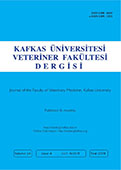
This journal is licensed under a Creative Commons Attribution-NonCommercial 4.0 International License
Kafkas Üniversitesi Veteriner Fakültesi Dergisi
2018 , Vol 24 , Issue 4
Anaplasma sp., Ehrlichia sp., and Rickettsia sp. in Ticks: A High Risk for Public Health in Ibagué, Colombia
1Instituto de Investigaciones Biológicas del Trópico, Facultad de Medicina Veterinaria y Zootecnia, Universidad de Córdoba, Montería, COLOMBIA
DOI :
10.9775/kvfd.2018.19581
The Order Rickettsiales comprises intracellular bacteria, including Rickettsiaceae and Anaplasmataceae; members of these families cause
zoonotic diseases transmitted by ticks. The aim of this study was to make a detection of Anaplasma, Ehrlichia and Rickettsia in ticks of
the Ixodidae (Acari: Ixodidae) family collected from domestic animals in Ibagué, Colombia. Ticks were collected from dogs, horses and
cattle, classified taxonomically, and then subjected to DNA extraction. To detect Anaplasma sp., Ehrlichia sp., and Rickettsia sp. we carried
out a conventional PCR to detect the gltA gene for Rickettsia, 16S rRNA for Anaplasma and Ehrlichia, and the dsb gene for Ehrlichia. The
phylogenetic trees were constructed with the Neighbor-Joining method. A total of 1.247 ticks, mainly R. microplus, R. sanguineus and D.
nitens, were collected. Anaplasma and Ehrlichia were detected in thirteen samples. The sequences showed a genetic similarity with E. canis,
E. mineirensis, A. phagocytophilum, and A. marginale. No Rickettsia was found. This is the first time that active circulation of Anaplasma and
Ehrlichia is demonstrated in Ibagué. Both pathogens are important because can produce economic losses in animals and humans disease.
This finding will contribute to the implementation of early epidemiological alerts, as well as the design of measures to prevent and control
diseases in the region.
Keywords :
Domestic animal, Environment and public health, Infectious disease vectors, Ixodidae, Molecular phylogeny, Tick










